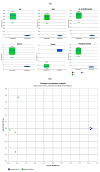Taxonomic and Functional Distribution of Bacterial Communities in Domestic and Hospital Wastewater System: Implications for Public and Environmental Health
- PMID: 34572642
- PMCID: PMC8470611
- DOI: 10.3390/antibiotics10091059
Taxonomic and Functional Distribution of Bacterial Communities in Domestic and Hospital Wastewater System: Implications for Public and Environmental Health
Abstract
The discharge of untreated hospital and domestic wastewater into receiving water bodies is still a prevalent practice in developing countries. Unfortunately, because of an ever-increasing population of people who are perennially under medication, these wastewaters contain residues of antibiotics and other antimicrobials as well as microbial shedding, the direct and indirect effects of which include the dissemination of antibiotic resistance genes and an increase in the evolution of antibiotic-resistant bacteria that pose a threat to public and environmental health. This study assessed the taxonomic and functional profiles of bacterial communities, as well as the antibiotic concentrations in untreated domestic wastewater (DWW) and hospital wastewater (HWW), using high-throughput sequencing analysis and solid-phase extraction coupled to Ultra-high-performance liquid chromatography Mass Spectrometry (UHPLC-MS/MS) analysis, respectively. The physicochemical qualities of both wastewater systems were also determined. The mean concentration of antibiotics and the concentrations of Cl-, F- and PO43 were higher in HWW samples than in DWW samples. The phylum Firmicutes was dominant in DWW with a sequence coverage of 59.61% while Proteobacteria was dominant in HWW samples with a sequence coverage of 86.32%. At genus level, the genus Exiguobacterium (20.65%) and Roseomonas (67.41%) were predominant in DWW and HWW samples, respectively. Several pathogenic or opportunistic bacterial genera were detected in HWW (Enterococcus, Pseudomonas and Vibrio) and DWW (Clostridium, Klebsiella, Corynebacterium, Bordetella, Staphylocccus and Rhodococcus) samples. Functional prediction analysis indicated the presence of beta-lactam resistance, cationic antimicrobial peptide (CAMP) resistance and vancomycin resistance genes in HWW samples. The presence of these antibiotic resistance genes and cassettes were positively correlated with the presence of pathogens. These findings show the risk posed to public and environmental health by the discharge of untreated domestic and hospital wastewaters into environmental water bodies.
Keywords: antibiotic resistance genes; antimicrobials; environmental health; public health; untreated wastewater.
Conflict of interest statement
The authors of this work declare no conflict of interest.
Figures





Similar articles
-
Microbiological Risks to Health Associated with the Release of Antibiotic-Resistant Bacteria and β-Lactam Antibiotics Through Hospital Wastewater.Pathogens. 2025 Apr 23;14(5):402. doi: 10.3390/pathogens14050402. Pathogens. 2025. PMID: 40430723 Free PMC article.
-
An integrated analysis of the use and potential risks of pharmaceutical drugs in hospital wastewater: Consumption and occurrence by suspect screening analysis, and antibiotic resistance.Sci Total Environ. 2025 Apr 10;973:179132. doi: 10.1016/j.scitotenv.2025.179132. Epub 2025 Mar 18. Sci Total Environ. 2025. PMID: 40101409
-
Metagenomic Analysis of the Abundance and Composition of Antibiotic Resistance Genes in Hospital Wastewater in Benin, Burkina Faso, and Finland.mSphere. 2023 Feb 21;8(1):e0053822. doi: 10.1128/msphere.00538-22. Epub 2023 Feb 2. mSphere. 2023. PMID: 36728456 Free PMC article.
-
β-Lactam antibiotics and antibiotic resistance in Asian lakes and rivers: An overview of contamination, sources and detection methods.Environ Pollut. 2021 Apr 15;275:116624. doi: 10.1016/j.envpol.2021.116624. Epub 2021 Feb 1. Environ Pollut. 2021. PMID: 33571856 Review.
-
High Burden of Antibiotic-Resistant Bacteria from Wastewater in Ethiopia: A Systematic Review.Risk Manag Healthc Policy. 2020 Dec 15;13:3003-3011. doi: 10.2147/RMHP.S277640. eCollection 2020. Risk Manag Healthc Policy. 2020. PMID: 33376424 Free PMC article. Review.
Cited by
-
Antimicrobial resistance profile of bacteria from hospital wastewater at two specialized hospitals in Bahir Dar city, Ethiopia.BMC Microbiol. 2024 Dec 19;24(1):525. doi: 10.1186/s12866-024-03693-8. BMC Microbiol. 2024. PMID: 39695370 Free PMC article.
-
Evolution and Emergence of Antibiotic Resistance in Given Ecosystems: Possible Strategies for Addressing the Challenge of Antibiotic Resistance.Antibiotics (Basel). 2022 Dec 24;12(1):28. doi: 10.3390/antibiotics12010028. Antibiotics (Basel). 2022. PMID: 36671228 Free PMC article. Review.
-
Can Wastewater Surveillance Enhance Genomic Tracking of Climate-Driven Pathogens?Microorganisms. 2025 Jan 28;13(2):294. doi: 10.3390/microorganisms13020294. Microorganisms. 2025. PMID: 40005661 Free PMC article. Review.
References
-
- Kaur R., Yadav B., Tyagi R.D. Current developments in Biotechnology and bioengineering. Elsevier; Amsterdam, The Netherlands: 2020. Microbiology of Hospital Wastewater; pp. 103–148.
-
- Ramganesh S., Timothy S., Venkatachalam S., Kamika I., Nel W.A.J. Industrial wastewaters harbor a unique diversity of bacterial communities revealed by high-throughput amplicon analysis. Ann. Microbiol. 2018;68:445–458.
-
- Asfaw T., Negash L., Kahsay A., Weldu Y. Antibiotic Resistant Bacteria from Treated and Untreated Hospital Wastewater at Ayder Referral Hospital, Mekelle, North Ethiopia. Adv. Microbiol. 2017;7:871–886. doi: 10.4236/aim.2017.712067. - DOI
LinkOut - more resources
Full Text Sources

